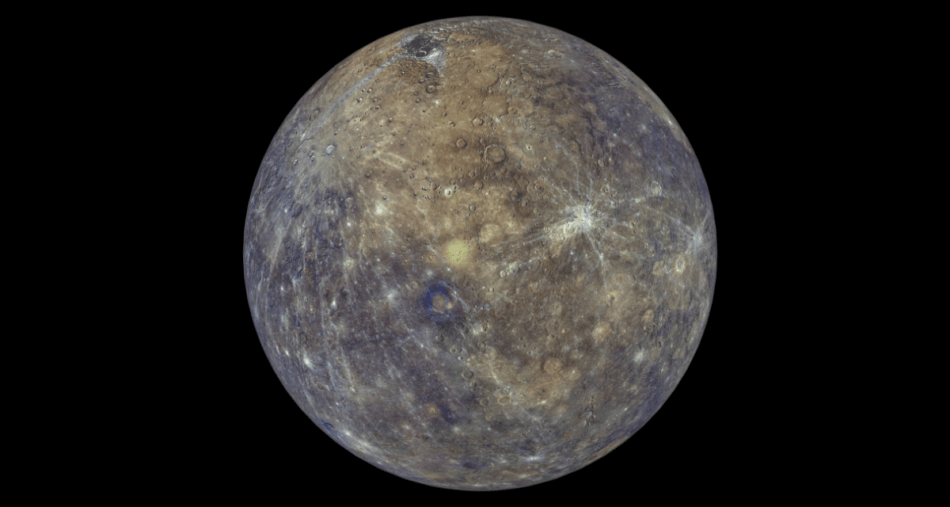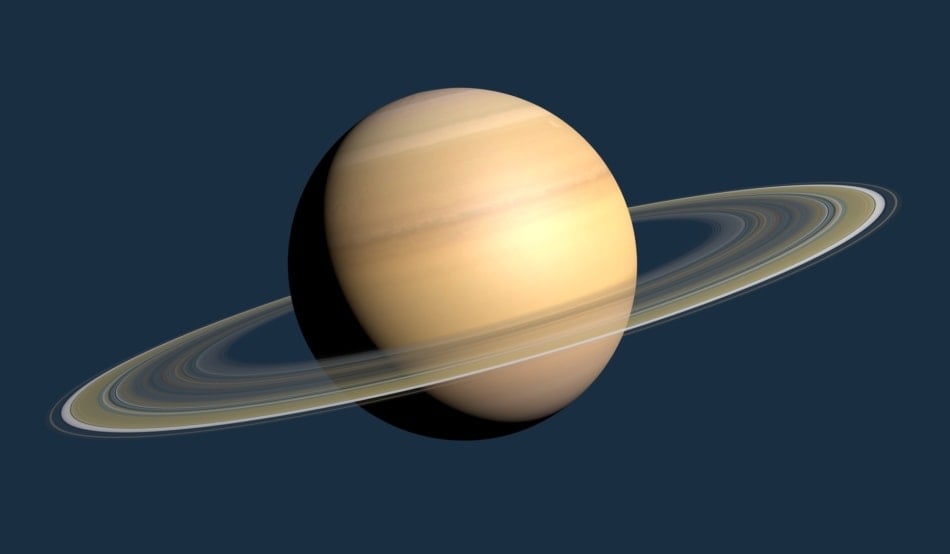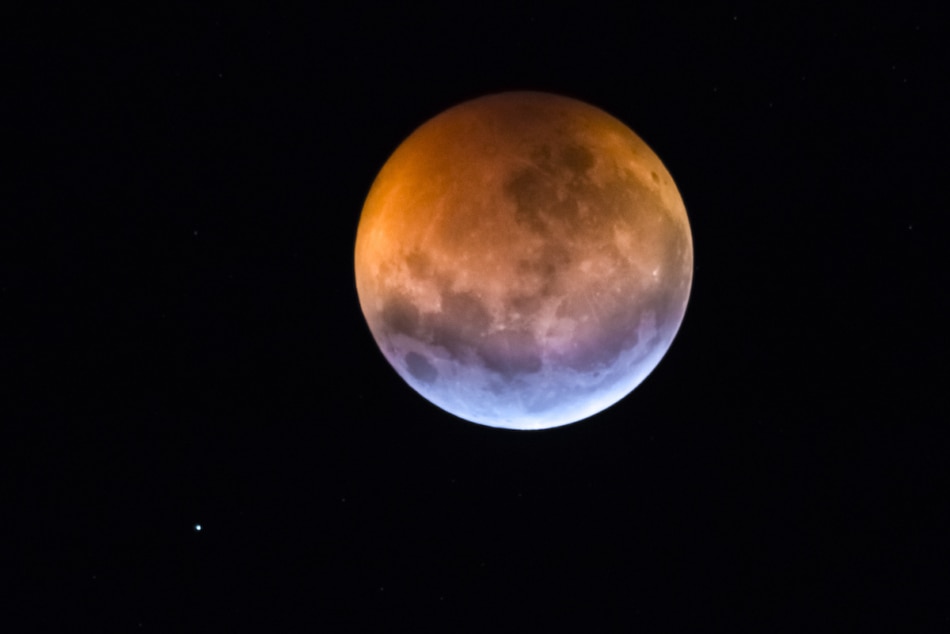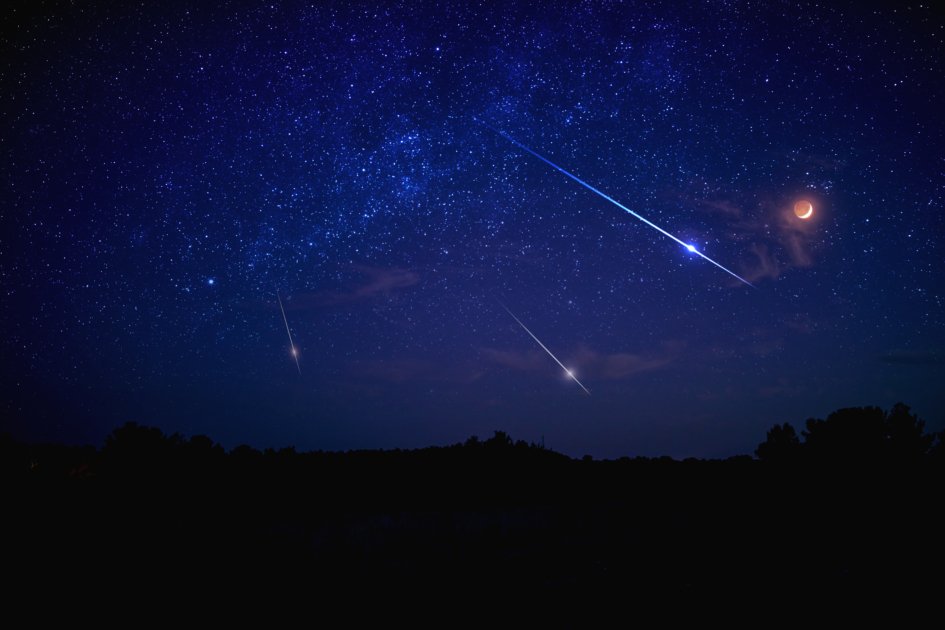Here’s our list of celestial events you’ll be able to see during the month of November. It will be an exciting month for viewing stunning planets, multiple meteor showers, a partial lunar eclipse, and the full Beaver Moon. Be sure to bookmark this page and refer to it all month long!
Take note that we sometimes will use angular degrees to define the separation between two objects, such as (for example) a bright planet and the Moon. Keep in mind that the width of your clenched fist, held at arm’s length, measures roughly 10°.
When we speak of magnitude, we are referring to the brightness of an object, the lower the figure of magnitude, the brighter the object. The brightest stars are zero and first magnitude. Under a dark, clear sky, the faintest objects that you can see with just your eyes are fifth or sixth magnitude. Objects with negative magnitudes are the brightest. Sirius, the brightest star, is -1.4. Venus can get as bright as -4.8. A full Moon is -12.7 and the Sun is a blindingly bright -26.7!
November Stargazing Calendar
All times are listed in Eastern Time for the Northern Hemisphere.
November 3—As November opens, Mercury rises in the east-southeast shortly after morning twilight begins. At that time this very bright “star” of magnitude -0.8 will be about 4½° to the left of the bluish first magnitude star Spica. Early this morning, hovering about 4° above Mercury is a slender sliver (3% illuminated) of a waning crescent Moon, about 36 hours from its new phase. Interestingly, the Moon will actually end up occulting (or hiding) Mercury for most of Canada (except the westernmost regions), as well as much of the central and eastern United States and Bermuda. However, for most locations, this event will take place in the daytime during the early-to-mid afternoon hours. Moving toward superior conjunction on the 29th, Mercury still rises an hour before sunup on November 8th but a few days later becomes too difficult to see.

November 4—New Moon at 5:14 p.m. In this phase, the Moon is not illuminated by direct sunlight and is completely invisible to the naked eye.
November 5-12—November provides two opportunities for meteor watching and tonight marks the peak of the Taurid Meteors, a shower of slow meteors rich in fireballs. About a dozen meteors per hour should be visible under dark skies, one day after the new Moon. The radiant—that point from where these meteors appear to emanate from the constellation Taurus—will cross the meridian about an hour before midnight. This display extends at reduced intensity for a week or more before and after maximum.
November 7—This evening, low in the west-southwest sky soon after sundown, look for a waxing crescent Moon sitting about 4½° to the lower right of Venus. This brilliant planet is nearing the peak of its evening apparition for northern observers, but that’s not saying much this year. Even at its highest in early December, Venus will be just 18° above the south-southwest horizon a half-hour after sunset for observers at latitude 40° north. Although the planet attained its greatest elongation of 47° from the Sun on October 29th, it was also very near its farthest southern declination. In fact, on November 6th it’s as far south (-27°14’) as it has been since 1930. Venus brightens from magnitude -4.6 to an awesome -4.9 during November and its crescent is equally exciting through telescopes, slimming from 48% to 29% lit while its tip-to-tip diameter increases by 33%.
November 10—As darkness falls this evening, that yellow-white “star” shining with a sedate glow about a half-dozen degrees to the upper right of the Moon is Saturn. The famous ringed planet, in Capricornus, is a bright light in the south at dusk. After we return to standard time, and with nightfall arriving so early in November, you can see Saturn through a telescope before dinner. In fact, you’d better hurry and take the opportunity—Saturn gets lower all evening, setting well before midnight. This month Saturn’s shadow extends most visibly to its east side onto its rings, which are tilted 19° from edge on with their north face in view.

November 11—First Quarter Moon at 7:46 a.m. In this phase, the Moon looks like a half-Moon in the sky. One-half of the Moon is illuminated by direct sunlight while the illuminated part is increasing, on its way to becoming a full Moon.
Also, this evening, the Moon will visit Jupiter. Look for them at dusk about one-third of the way up in the south-southeast sky; Jupiter will appear about 5° above and slightly to the right of our natural satellite. It’s the brightest planet after Venus, and when we transition back to standard time on the 7th, Jupiter sets around 11:40 p.m., but around 10:20 p.m. by month’s end (for viewers at mid-northern latitudes). In addition to examining the planet’s disk in your telescope, but sure to catch the ever-changing parade of its four Galilean satellites. Jupiter is at eastern quadrature (90° east of the Sun) on November 15th.
November 17—Swift meteors from the Leonid Meteor Shower will streak away from the Sickle of Leo during the latter part of the month, but probably in reduced numbers for most observers. The comet (55P/Tempel-Tuttle) that produces spectacular meteor displays at roughly 33-year intervals arrived at aphelion, beyond the orbit of Uranus in 2014, and as a result, the Leonids have been weak in recent years. The maximum of this year’s display occurs this morning when about 10 meteors per hour are predicted for observers with ideal conditions. The waxing gibbous Moon will set about 20 minutes or so before morning twilight begins; this short period is the best time to look for any Leonid meteors whose radiant will then be high in the eastern sky. As many as half leave visible trains.
November 19—The Full Beaver Moon at 3:57 a.m. EST. Here’s how this Moon got its name. Watch our short video, below!
November 19—Partial Eclipse of the Moon – An “almost” total lunar eclipse also occurs this morning. See the Moon glow like a Japanese lantern! See the timetable, and read more about this partial lunar eclipse here.

November 27—Last Quarter Moon at 7:27 a.m. In this phase, the Moon appears as a half Moon due to the direct sunlight; the illuminated part is decreasing toward the new Moon phase.
November 29—Mercury in superior conjunction and transitions from the morning into the evening sky. Also, you might want to begin searching for Mars as it begins to emerge from the glare of the Sun, rising shortly after the break of dawn, low in the east-southeast sky. Use binoculars, as it ranks only as bright as a second magnitude star.
By Farmers’ Almanac Astronomer Joe Rao. This calendar is adapted from “Skylog,” a regular feature appearing in Natural History magazine written by Mr. Rao since 1995.

